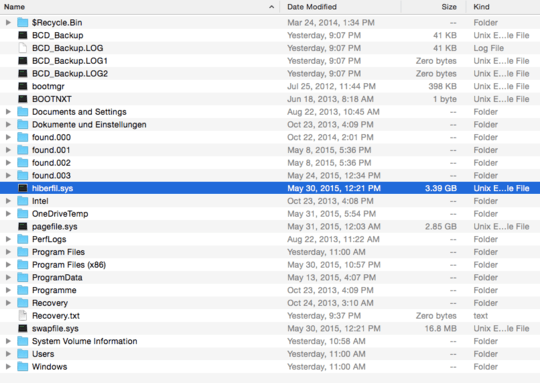4
1
thank you for reading my post!
I am running Windows 8.1 in Bootcamp on my Macbook. For over a year I didn't have any trouble with it. Yesterday, the Windows partition failed to boot and I get a blue screen error since. It says 'Inaccessible boot device'.
First, I tried to start in safe mode, but still got the blue screen. I was looking for a solution online and came across some posts where people had similar problems.
They recommended to run the following commands in terminal: bootrec /rebuildbcd bootrec /fixboot chkdsk C: /f /r /x
But none of them helped to boot the Windows partition.
In OS X, the Windows partition is still showing up using Disk Utility as well as in the Finder.
However, the Bootcamp partition is listed under Devices and I cannot access any files/folder as they seem to be empty.

Any ideas how to fix this? Would highly appreciate any help!
Update:
I mounted the Windows EFI boot loader files and it looks like I did perform an EFI mode installation of Windows.
bootmgfw.efi is located in Windows/Boot/ as well as boot.stl, bootmgr.efi, memtest.efi and BCD and some language specific folders.
As far as I remember, I installed it as follows: I created two partitions using Boot Camp Assistent on the Mac and created a Windows installation USB drive from a Windows 8 ISO file.
However, when installing Windows, it wanted me to partition the Bootcamp partition and that's how I got these two other partitions. I'll attach a screenshot of Disk Utility on the bottom.
I still don't get what went wrong! After closing the Macbook (when using Windows) and trying to re-open it a few minutes later, I couldn't get Windows to wake-up, so I had to long-pres the power button. Ever since, I get the blue screen error.

If you recieve a blue screen it likely means a .dmp file is being created. Can you provide us the .dmp file that is being created upon encoutering BSOD? By the looks of it, it looks like your windows partition ran chkdsk and recovered corrupted files, if thats the case its also likely you have corrupted system files. If you have corrupted system files your options are extremely limited. This cannot be solved without a recovery disk – Ramhound – 2015-06-02T14:47:22.457
Thank you for your help. I indeed ran chkdsk, because that's what people recommended somewhere else. I hope that it didn't corrupt the OS. Where can I find the .dmp file? – user3260254 – 2015-06-02T15:28:00.903
Also: I created a USB drive from a Windows 8.1 ISO, but does it include recovery tools? – user3260254 – 2015-06-02T15:43:25.733
Update: I was wrong, I am still able to access all files and folders on the Bootcamp partition, so there is probably a problem with allocating the correct partition when booting the system. – user3260254 – 2015-06-02T18:41:42.873